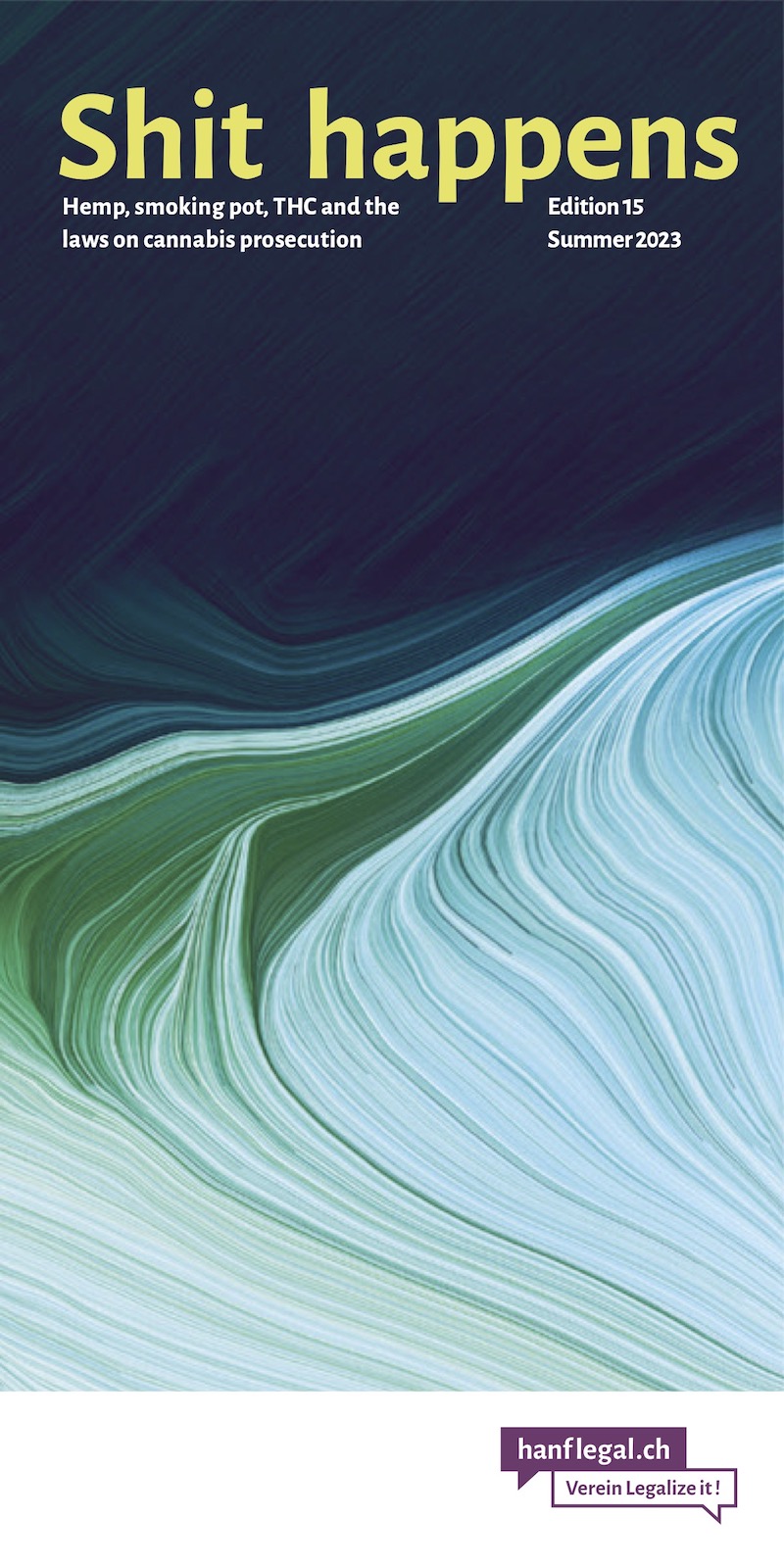- THC & Law:
Tolerance, withdrawal symptoms and dependence with THC
THC products have a very low risk potential. Many THC users stop using between the ages of 30 and 40 or drastically reduce the amount they use. This is practically without withdrawal symptoms.
About the term tolerance
Tolerance means that at a constant dose the effect decreases and consequently the dose must be increased to achieve the same effect. Tolerance development is described for almost every cannabis effect. The exact mechanisms are not yet fully understood. One assumes an adaptation of the cannabis receptors in the brain. In this process, the speed of degradation of cannabinoids increases, the stimulus threshold of the receptors increases, and the number of receptors decreases. However, all of these changes are reversible, meaning that after a certain period of abstinence, they return to the baseline situation as before use. There is a cross-tolerance to some drugs. This means that the tolerance formed by the use of cannabis also has an effect on other substances. However, there is no cross-tolerance to other drugs such as hallucinogens, amphetamines or opiates. Studies of tolerance often show that with continued use, the positive effects, such as euphoria (feelings of happiness), diminish over time. But physiological (physical) components, such as the increase in heart rate, also increasingly diminish.
About the term withdrawal symptoms
The most common withdrawal symptoms described by cannabis users after they stop using are: Anxiety, insomnia, appetite disturbances, increased sweating, nervous irritability, and depressive moods. A correlation was also found between abstinence symptoms and THC dose and frequency of use.
How dangerous is THC use?
Here is another example of how cannabis opponents try to convince the public how dangerous cannabis can be. This is a study conducted on behalf of the NIDA (National Institute on Drug Abuse). Researchers administered high-dose infusions of THC to mice continuously for four days. They were then given an antagonist (a type of cannabinoid blocker). This antagonist displaced the THC from the receptors in one fell swoop, greatly forcing withdrawal symptoms in the animals. These findings were then used to prove how physically addictive cannabis can be. However, since no human willingly ingests such a cannabinoid blocker after they have stopped using, these results are completely irrelevant to humans. Many of the more recent books and articles warning about cannabis addiction have been written by people who have designed programs to help addicts. Of course, these people profit immensely from the ever-increasing number of allegedly addicted users who, intimidated by such articles, seek treatment in rehab clinics.
Dependence and risk factors
There are two major clinical manuals that contain the criteria of addiction: The DSM-IV (USA) and the ICD-10 (Europe). The following table lists the criteria for substance dependence according to ICD-10.
Criteria of substance dependence according to ICD-10
1) Strong desire or some kind of compulsion to use drugs/medication.
2) Decreased ability to control drug/medication use in terms of onset, cessation, or amount
3) A physical withdrawal syndrome.
4) Evidence of tolerance development
5) Narrowing down to drug/medication use.
6) Continued drug/medication use despite clearly harmful consequences
The term "addiction
In addiction research, a distinction is made between psychological and physical dependence. The terms “addiction” and “dependence” are explained in more detail below. In scientific literature, a distinction is often made between “addiction in the broader sense” as any compulsive satisfaction of a need and “addiction in the narrower sense” as an abuse of intoxicants that has become compulsive.
In 1964, the World Health Organization (WHO) officially replaced the term “addiction” with the term “dependence,” distinguishing between physical and psychological dependence.
Physical dependence
This is characterized by a series of physical and psychological phenomena that occur after withdrawal. The withdrawal effects differ for the individual drugs. Physical dependence, in contrast to psychological dependence, is the expression of a pathological interaction between the person and the drug in question. Important here is the pharmacological term tolerance, which means that the dose of a substance must be increased in order to achieve the same effect.
Psychological dependence
According to WHO, the irresistible desire to continue taking a drug periodically or continuously to produce pleasure or avoid discomfort.
The term substance dependence
Addiction is closely related to the term substance dependence. The main feature of substance dependence is a characteristic pattern of thought-related, behavioral, and physical symptoms that indicate that the individual continues substance use despite drastic substance-related problems. A pattern of repeated substance use is present, usually leading to tolerance development, withdrawal symptoms, and the irresistible urge (English: craving) to use drugs.
What about THC products?
The physical dependence potential of cannabis is very low. When the substance is discontinued, the withdrawal symptoms already mentioned may occur, but these disappear after a few days. A psychological dependence, on the other hand, cannot be ruled out in certain people with a corresponding personality structure. This is especially true for psychologically unstable people who create “artificial” feelings of happiness by consuming cannabis without making any other attempts to achieve happiness and satisfaction. On a physical level, there is evidence that cannabinoids increase dopamine concentrations in certain brain regions responsible for addictive behavior (dopaminergic transmitter system). However, it should be noted that the underlying effects for this in humans are not yet fully known.
Various factors may have an influence on whether or not someone develops an addiction. Twin studies indicate that if one twin has developed a dependence, the likelihood that the other will also develop a dependence is greatest in identical twins. In addition to these genetic factors, the age at which cannabis use began, as well as psychological lability and the personality trait “impulsivity” also play a role in the development of dependence. The table above shows the dangerousness of cannabis in comparison with other substances.
As can be seen from the table, cannabis is relatively harmless compared to other drugs, both illegal and legal. Both the physical and the psychological risk of dependence is comparatively low. Nerve damage could not be confirmed, contrary to certain populist studies from the USA. The overall toxicity is also quite low, except for the increased risk of cancer if cannabis is smoked.
Our experience from practice
In the last fifteen years that we have been working on the topic of THC use, we have not encountered anyone who has had major social or health problems because of hash and weed use. This is because all the people who have realized that THC use is not good for them (anymore) have simply stopped using it. Negative effects occur because people do not have time (anymore) to enjoy THC - for example, because they start a family and are fully committed there. Or they want to make a career and now give higher priority to striving at work than to enjoying hash and weed. Some also realize that the formerly pleasant effects of THC are no longer important to them - they now have other sources of pleasure. All of these people, predominantly between the ages of 30 and 40, have stopped using THC. Just like that. Without withdrawal cures and without medical help. Many even from one day to the next.
Others find that the positive effects aren't so great anymore - they've developed a tolerance to THC, so the euphoric, elated feelings are much less strong than they were in the beginning. These people now take regular breaks from using so that the desired, nice effects can be fully achieved again. Smoking is only a problem for those users who smoke a lot of joints. This is also the worst effect of THC consumption: the lungs are obviously damaged by the smoke. For such users it is strongly recommended to switch from smoking to eating or vaporizing. Because the lung tissue is only capable of regeneration to a limited extent.
All those people who consume THC and who obviously have other problems, have these problems regardless of THC consumption. Those who do not look after their body, who do not make an effort at work, who do not take care of their social network, naturally have problems in life. But these problems are not caused by THC use, they are caused by this inability to cope with life and its challenges. With such people, even THC abstinence does not help - the problems remain. And vice versa: If such people tackle their problems and find solutions for them, they can continue to enjoy THC products.
Support our work with a donation:
Bank transfer
Account number (IBAN):
CH02 0900 0000 8709 1354 3
Full account details
Or scan this QR code with your eBanking App (ZKB, Revolut, Postfinance, …):

Or open/share the QR code as PDF file with your eBanking App.
Credit card
Donate via credit card
Verein Legalize it!
Quellenstrasse 25
8005 Zürich
Threema ID 7NH65RBY
Don’t miss anything! Follow us on social media:


